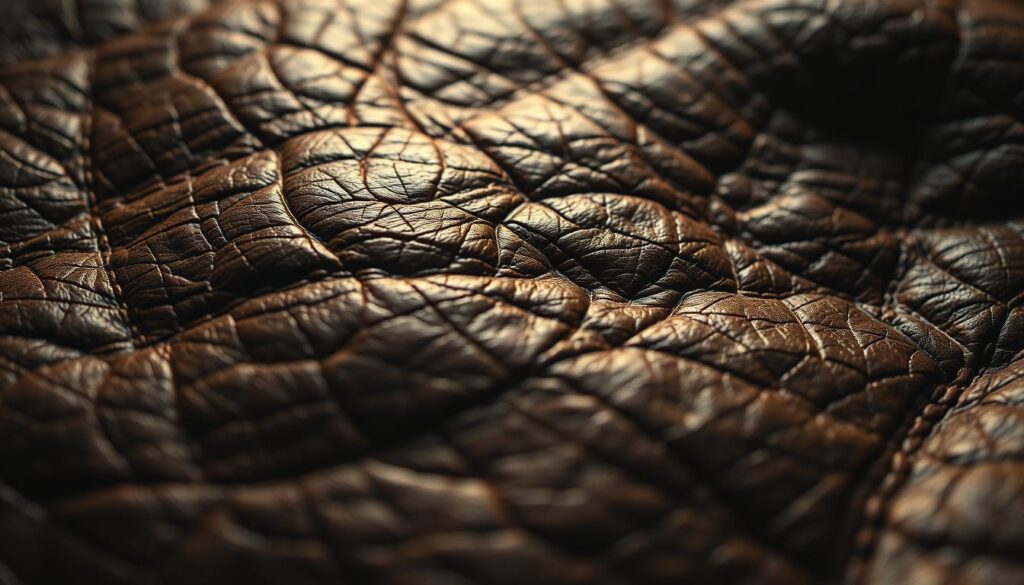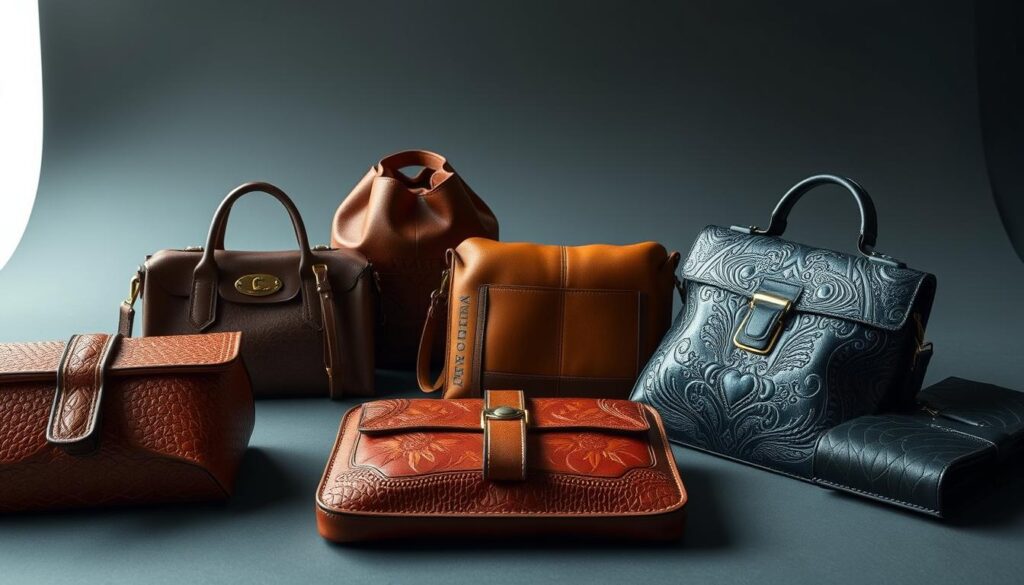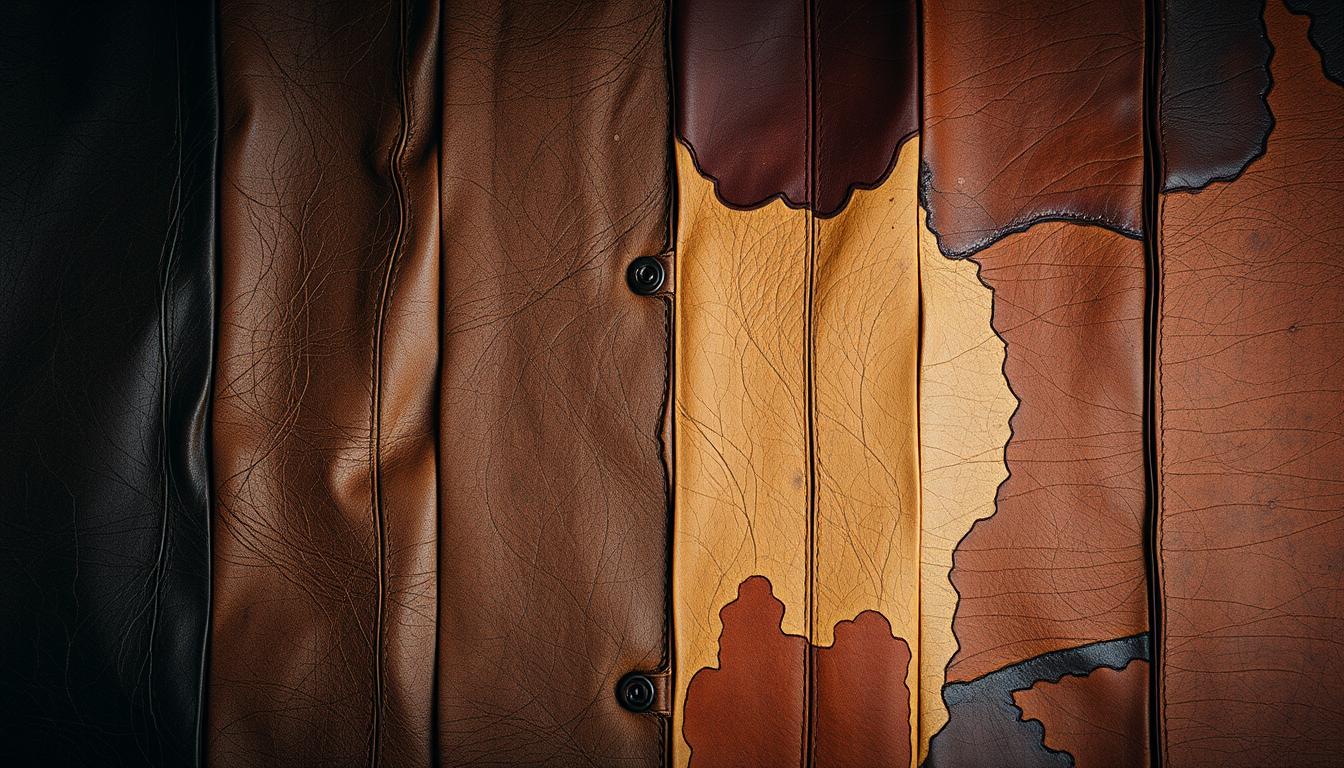Ever noticed how some leather items get better with age? It’s not magic, it’s patina. But not all leather ages the same. Low-quality leather often looks worn out quickly, while premium leather develops a rich character over time.
This leaves many wondering: what’s the secret behind leather aging? Let’s dive into the world of leather quality and discover how it impacts the aging process.
Key Takeaways
- High-quality leather develops a desirable patina over time
- Full-grain and top-grain leathers exhibit the best patina
- Patina formation is influenced by heat, sunlight, oils, and moisture
- Vegetable-tanned leather develops patina faster than chrome-tanned
- Regular use accelerates the development of leather patina
- Proper care enhances the beauty of aged leather
Understanding Leather Patina: Nature’s Artistry
I’ve always been fascinated by how leather changes over time. This natural aging process, known as leather patina, turns high-quality leather into a unique work of art. Let’s explore the world of leather patina and its captivating nature.
What is leather patina?
Leather patina is the beautiful transformation that happens as leather ages. It’s not just wear and tear. It’s a change in color, texture, and appearance that gives leather character. This process is especially noticeable in full-grain leather, which develops a rich, personalized look over time.
The science behind patina formation
The leather aging process involves several chemical reactions. Oxidation plays a key role in patina formation. The leather interacts with air and moisture, leading to subtle color changes and a softer feel. It’s fascinating to watch this natural process unfold on my leather goods.
Factors influencing patina development
Many elements contribute to patina development. Heat, sunlight, skin oils, and moisture all play a part. Even the way I use my leather items affects how their patina forms. Here’s a breakdown of key factors:
| Factor | Effect on Patina |
|---|---|
| UV Radiation | Darkens leather, enhances color depth |
| Skin Oils | Softens leather, creates unique patterns |
| Moisture | Alters texture, can deepen color |
| Wear and Tear | Develops creases, adds character |
Understanding these factors helps me appreciate the unique story each leather item tells through its patina. It’s a beautiful process that makes leather goods more personal and valuable over time.
The Hierarchy of Leather Quality
Leather grades have a clear order. Full-grain leather is at the top. It’s the best and keeps all natural markings. It also gets a beautiful patina over time.
Then, we have top-grain leather. It’s smoother and more even than full-grain. This is because it’s been buffed and sanded. It’s still very high quality, even if it doesn’t soak up oils and water like full-grain.
Split-grain leather comes next. It includes suede, which is soft and used in shoes and handbags. At the bottom, we find genuine and bonded leather. These are processed a lot and not as durable as the higher grades.
| Leather Grade | Characteristics | Common Uses |
|---|---|---|
| Full-grain leather | Natural markings, develops patina | High-end goods, wallets |
| Top-grain leather | Smooth, uniform, water-resistant | Luxury items, jackets |
| Split-grain leather | Soft, pliable, no natural markings | Shoes, handbags |
| Genuine leather | Heavily processed, less durable | Mass-produced goods |
| Bonded leather | Made from scraps, least durable | Budget items, furniture |
Most leather products are 1.2-1.6mm thick. This thickness is perfect for being both strong and flexible. It’s great for many uses.
Full-Grain Leather: The Gold Standard for Aging
I find full-grain leather aging fascinating. It’s like watching nature create art right before us. This leather is top-notch in quality and lasts a long time.
Characteristics of full-grain leather
Full-grain leather is real and keeps its natural look. It has unique patterns and marks. This leather is strong and lasts long because of its dense fibers.
It also breathes well, making it great for shoes and clothes.
How full-grain leather develops patina
Full-grain leather gets a beautiful patina over time. As you use it, it absorbs oils and moisture. This creates a stunning aged look.
This aging process makes the color deeper and more unique. Each piece becomes truly special.
Examples of full-grain leather patina
Full-grain leather patina is amazing in many items. I saw a Jayee Home sofa made from 100% Italian leather. Its aging was incredible.
The patina added depth and character. It turned the sofa into a masterpiece. This is why full-grain leather is the best choice for those who love leather’s beauty and durability.
Top-Grain Leather: A Balance of Quality and Consistency
I’ve always been fascinated by top-grain leather. It’s the second-highest quality leather. It offers a perfect balance between durability and beauty.
This type of leather is made by sanding the top layer of the hide. This removes surface imperfections, making it smoother and more uniform. It ages beautifully over time, even if it doesn’t show patina as fast as full-grain leather.
Top-grain leather is very versatile. It’s used in high-end products like designer handbags, furniture, and shoes. Its consistent texture is perfect for items needing a uniform look.
Let’s compare some characteristics of top-grain leather with other leather types:
| Characteristic | Top-Grain Leather | Full-Grain Leather | Genuine Leather |
|---|---|---|---|
| Quality Ranking | Second-highest | Highest | Lower |
| Surface Texture | Smooth, uniform | Natural, varied | Less consistent |
| Durability | High | Highest | Moderate |
| Patina Development | Slower, less pronounced | Quicker, more pronounced | Limited |
| Maintenance | Easy | Moderate | Easy |
In my experience, top-grain leather offers excellent value. It combines quality and consistency. It’s a popular choice for those who love fine leather goods but want a uniform look.
How Leather Ages Based on Quality
I’ve always been fascinated by how leather ages. It’s amazing how different types of leather age uniquely. Let’s explore how tanning methods affect leather aging.
Comparing Aging Processes Across Leather Grades
Full-grain leather ages the best. It gets softer and more beautiful with time. Top-grain leather also ages well but doesn’t get as deep as full-grain. Genuine leather tends to wear out instead of aging beautifully.
The Role of Tanning Methods in Leather Aging
Tanning methods greatly affect leather aging. Vegetable-tanned leather gets a beautiful patina fast, often in 6 months. Chrome-tanned leather ages less because of its synthetic coatings. It’s interesting to see how these methods change leather’s look over time.
Visual Indicators of Quality Leather Aging
Good leather aging shows in several ways. The color gets deeper and richer, especially where it’s used a lot. The texture becomes softer and shiny. You might see unique marks or patterns that tell the leather’s story.
The Allure of Aged Leather: Why Patina is Desirable
I’ve always been fascinated by the aged leather appeal. There’s something magical about how leather transforms over time. It develops a rich patina that tells a unique story. This natural aging process is highly sought after by leather enthusiasts, with 85% valuing patina as a sign of quality and authenticity.
The leather patina benefits are numerous. As leather ages, it often becomes softer and develops a protective layer. This increases durability and value. In fact, 9 out of 10 customers associate a well-developed patina with high-quality leather goods, influencing their purchasing decisions.

Vintage leather with patina is not just about looks. A consumer survey revealed that 70% of participants appreciate how patina enhances the luxury appearance of leather goods. The remaining 30% value the unique journey each patina represents on their accessories.
| Patina Type | Consumer Preference |
|---|---|
| Petroleum-derived | 60% |
| Wax-coated | 30% |
| Stain-treated | 10% |
The development of patina is a slow but rewarding process. It can take 6 months to 2 years for high-quality leather to fully develop a desirable patina, depending on use. This natural aging is influenced by various factors: 90% from skin oils, 5% from UV exposure, and 5% from handling and storage conditions.
Caring for Your Leather to Enhance Patina Development
I love how leather ages, getting a unique look over time. To get that perfect patina, you need to take good care of your leather. Let’s explore some top ways to clean, condition, and protect your leather items.
Cleaning and Conditioning Techniques
Cleaning your leather regularly is key. I use a soft, damp cloth to remove dirt and dust. For stubborn stains, a mild soap solution works great.
After cleaning, I apply a top-notch leather conditioner. This keeps the leather soft and healthy.
Protecting Leather from Harmful Elements
To keep your leather looking great, protect it from too much water and sunlight. I use a waterproofing spray to guard against spills. When not in use, I store my leather in a cool, dry spot, away from heat.
Balancing Use and Care for Optimal Patina
The secret to a great patina is finding the right balance. Using your leather regularly helps it develop character. But, taking good care of it ensures it ages well.
I condition my leather every six months. This keeps its patina looking good without losing its charm.
| Leather Type | Patina Development | Care Frequency |
|---|---|---|
| Full-grain | Distinct patina | Every 3-6 months |
| Top-grain | Less distinct patina | Every 4-8 months |
| Genuine | No patina | As needed |
By following these care tips, you’ll not only keep your leather safe but also make it more beautiful with patina.
Common Misconceptions About Leather Aging
I’ve seen many myths and misconceptions about leather aging. Let’s clear up some common beliefs.
Many think all leather gets a beautiful patina over time. But, only top-quality leathers like full-grain and top-grain get this look. Lower-quality leathers often just wear out.
Some believe patina makes leather weak. But, that’s not true. Good aging can actually make leather stronger, lasting for decades with little care.
Others think you can make leather age faster. But, aging is a natural process for each piece. Trying to speed it up can harm the leather.
- Myth: All leather needs intense care
- Fact: High-quality leather requires less maintenance
- Myth: Leather aging is uniform
- Fact: Each piece ages uniquely based on use and care
Knowing these facts helps us see the real beauty of quality leather as it ages.
Leather Patina in Different Products: From Wallets to Furniture
Leather products patina in different ways. It’s interesting to see how high-quality pieces age. Let’s look at how patina forms on various leather goods.
Small leather goods and patina formation
Wallets and card holders patina fast. My full-grain leather wallet got a rich patina in months. Oils from my hands and use speed it up.
Leather bags and briefcases: A canvas for patina
Bags and briefcases show off patina well. My top-grain leather briefcase has unique wear and color changes. After a year, it’s full of character.
The patina on these items is unique. It gives them a beautiful, lived-in look.
Leather furniture: Long-term patina development
Leather furniture aging is slow but rewarding. My leather couch has changed over years. The patina develops slowly, with color and texture changes.
This slow aging makes the furniture more appealing and valuable over time.
| Product Type | Patina Development Speed | Influencing Factors |
|---|---|---|
| Wallets | Fast (weeks to months) | Frequent handling, body oils |
| Bags/Briefcases | Medium (months to a year) | Regular use, environmental exposure |
| Furniture | Slow (years) | Less frequent contact, indoor conditions |
The Future of Leather: Innovations in Aging and Quality

I’m excited about the future of leather aging and quality. The leather industry is changing fast. It’s now focusing on sustainable leather and new techniques.
New tanning methods are coming up. They make eco-friendly leather that looks great over time. This change is making leather goods better and more sustainable.
Leather innovations are bringing new things. 3D printing is changing leather making, especially for custom items. It lets us create detailed designs and personal touches that were hard before.
More people are using sustainable materials. Leather made from things like pineapple leaves and cork is becoming popular. These options are good for the planet and look unique.
| Innovation | Impact on Leather Aging | Sustainability Factor |
|---|---|---|
| 3D Printing | Enhanced customization | Reduced material waste |
| Plant-based Alternatives | Unique patina development | Lower environmental impact |
| Digital Design Integration | Improved aging predictions | Less physical prototyping |
Digital design is changing the leather world. Tools let designers see how leather will age. This means less waste and more creativity in making leather goods.
The future of leather aging is looking good. It’s a mix of old skills and new tech. I’m excited to see how these changes will make leather goods even better.
Conclusion
Leather quality is very important for aging. Top-grain and full-grain leather are the best for showing off their beauty. They start to show their unique look in just a week. But, it takes up to a year to see their full beauty.
Appreciating patina means more than just looking at it. It’s about how it protects the leather. This natural aging makes leather stronger against spills and scratches. The shiny look that comes with time shows the leather’s quality and care.
How we use and take care of leather affects its patina. Handling it, sunlight, rain, and oils all play a role. If you want to speed up aging, you can use special techniques. But, being patient often gives the best results.
The charm of aged leather is in its uniqueness. Every mark and change tells a story, making each piece special. Whether you love leather or just own some, knowing about aging helps. It ensures your leather goods will age well and last for many years.
